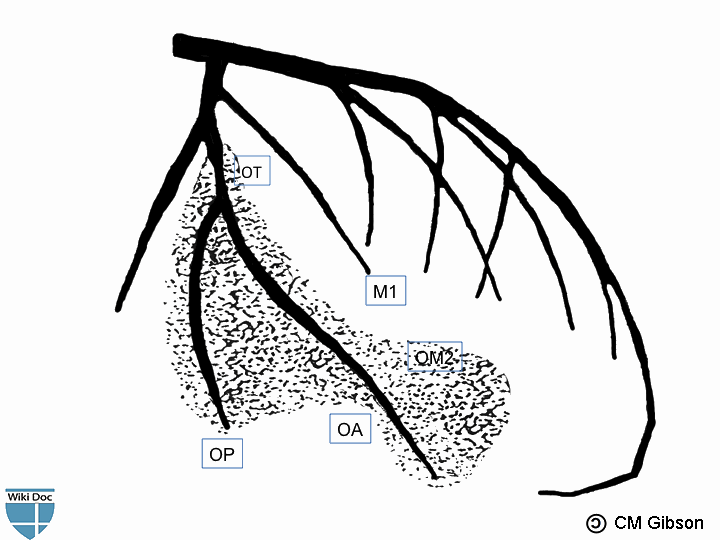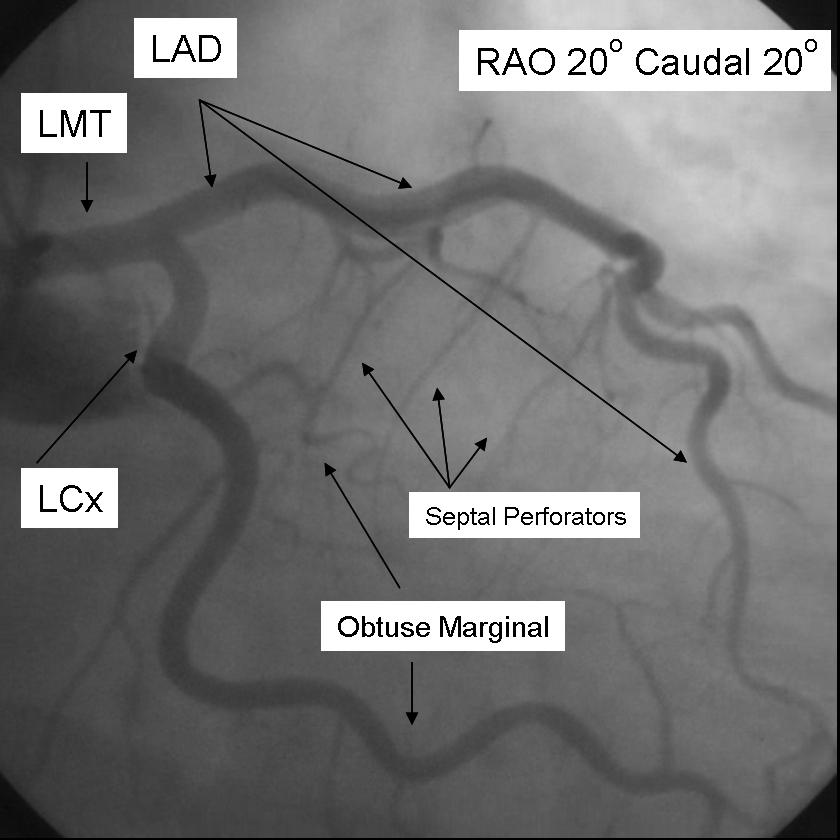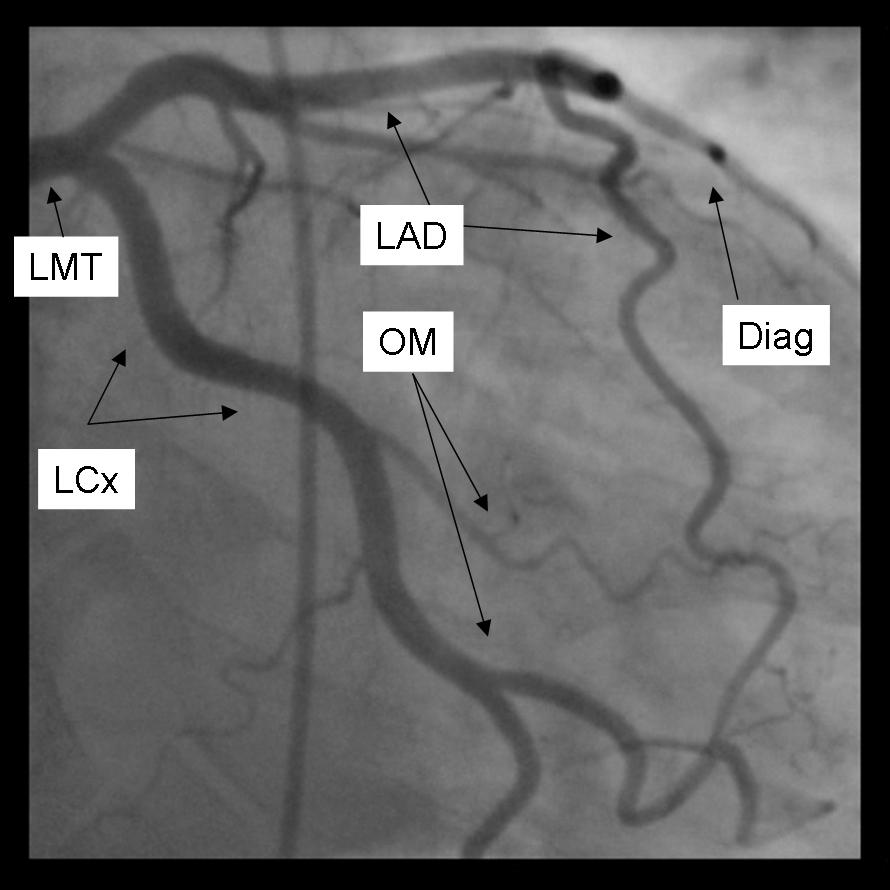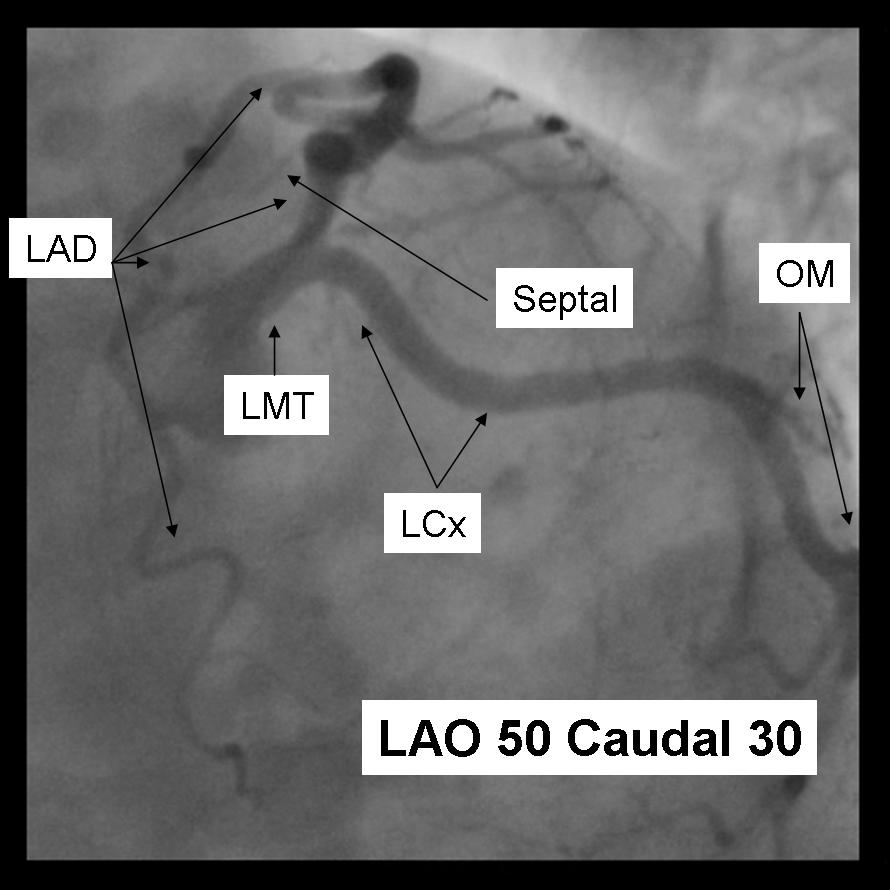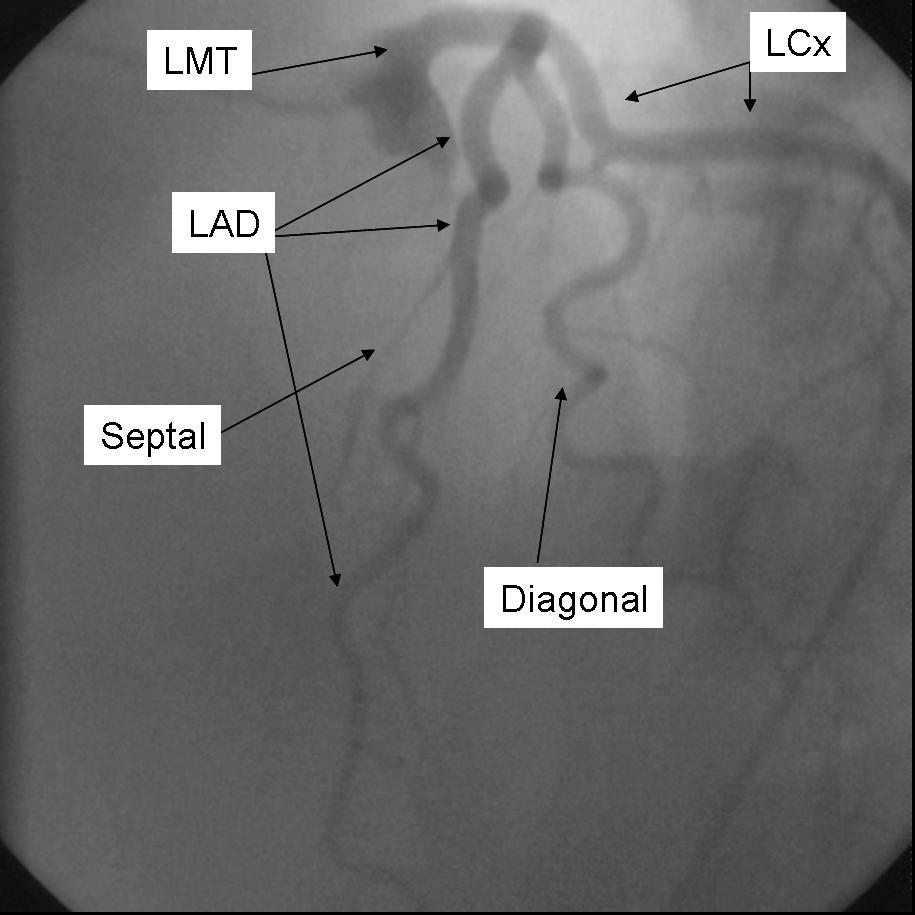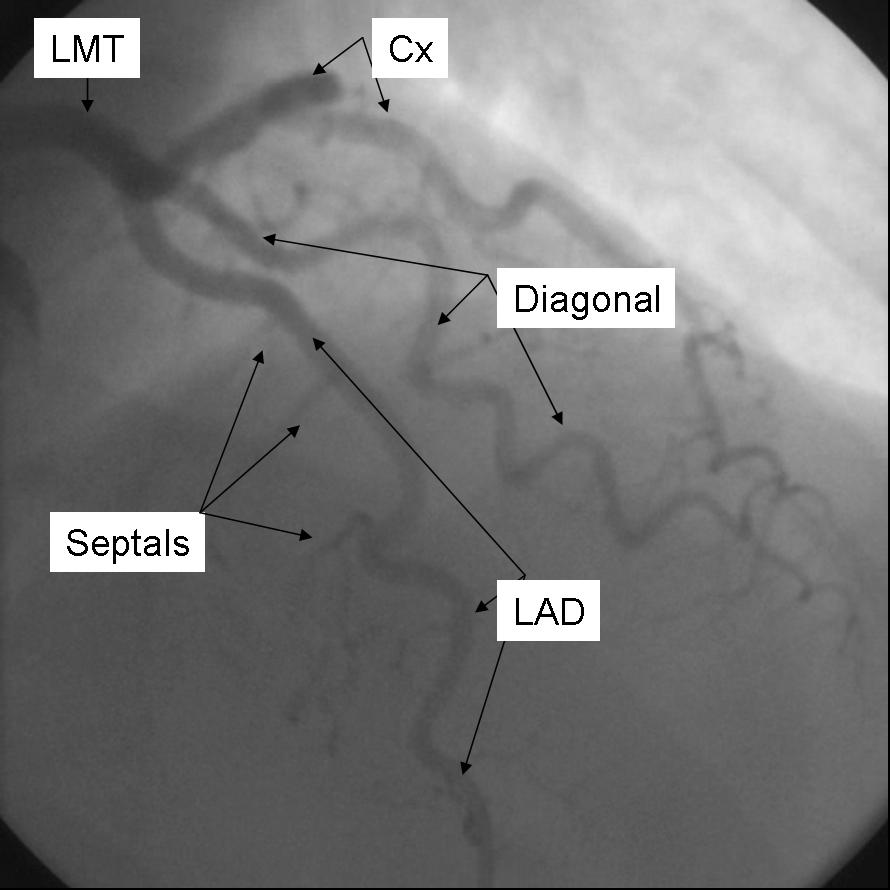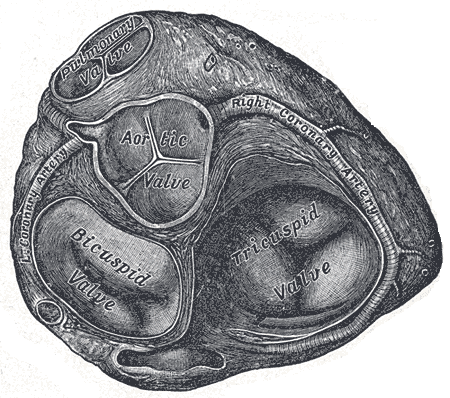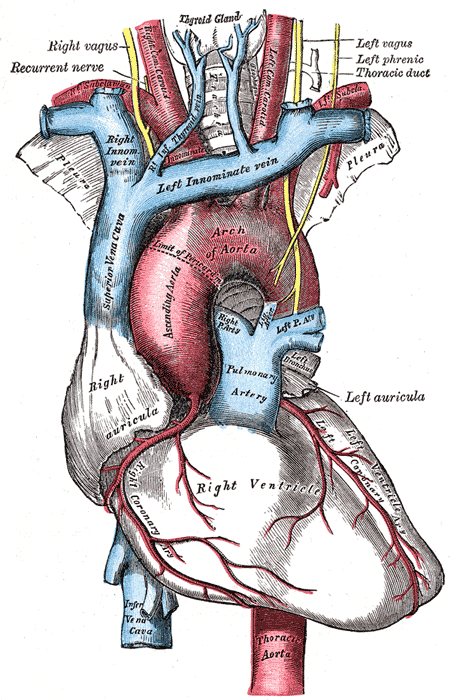Left coronary artery
Editor-In-Chief: C. Michael Gibson, M.S., M.D. [1]
Synonyms and keywords: LCA
Overview
The left coronary artery normally arises from the aorta above the left cusp of the aortic valve. The origin of the left coronary artery is called the left main coronary artery, and it bifurcates into the left anterior descending and the left circumflex artery. This artery supplies the majority of the blood flow to the left ventricle, the pumping chamber of the heart.
Branches
The left coronary artery typically courses for 1 to 25 mm as the left main artery, and then bifurcates into the anterior interventricular artery (also called left anterior descending (LAD)) artery and the left circumflex artery (LCX).
If an artery arises from the left main between the LAD and LCX, it is known as the ramus intermedius. The ramus intermedius occurs in 37% of the general population, and is considered a normal variant.
The left coronary artery arises from the left aortic sinus. It bifurcates (divides or branches into) the Left anterior ascending artery (also known as the LAD or the anterior interventricular artery) and the Left circumflex artery (also known as the circumflex, circ, or LCX). It supplies the anterior part of the left ventricle: anterolateral myocardium, apex, anterior interventricular septum, anterolateral papillary muscle.
It supplies the posterolateral side of the left ventricle.
Segments
LCA with median ramus and marginal branches
File:LCA with median ramus.png
LCA with obtuse marginal branch
Table
| Segment number | Segment label | Segment location | Segment discription | |
|---|---|---|---|---|
| 11 | LM | Left main | Extends from the origin of the left coronary artery to the bifurcation into the left anterior descending and circumflex arteries. | |
| 12 | L1 | Proximal left anterior descending artery | Extends from the bifurcation of the left main coronary artery to the origin of the first septal artery. | |
| 13 | L2 | Mid left anterior descending artery | Extends from the origin of the first septal artery to the origin of the third septal artery. | |
| 14 | L3 | Distal left anterior descending artery | Extends from the origin of the third septal artery to the apex of the left ventricle. If there is no third septal branch, then the third segment begins halfway between S1 and the apex of the left ventricle. | |
| 15 | L4 | The left anterior descending artery terminus on the inferior wall | The continuation of the left anterior descending artery beyond the apex of the left ventricle in the event that the LAD is a wrap around variant. | |
| 16 | D1 | First diagonal artery | The first of the three longest branches off of the left anterior descending artery which supplies the anterolateral wall of the left ventricle. | |
| 17 | D2 | Second diagonal artery | The second of the three longest branches off of the left anterior descending artery which supplies the anterolateral wall of the left ventricle. In an RAO projection, this artery often arises where the left anterior descending angles toward the apex. | |
| 18 | D3 | Third diagonal artery | The third of the three longest branches off of the left anterior descending artery which supplies the anterolateral wall of the left ventricle. In an RAO projection, this artery often arises where the left anterior descending angles toward the apex. | |
| 19, 20, 21 | S1, S2, S3 | Septal arteries | The three largest branches off of the left anterior descending supplying the septum. | |
| 22 | MR | Median Ramus | An artery whose origin bisects the origins of both the left anterior descending artery and the circumflex artery. When a median ramus branch is present, the left main will be seen to trifurcate in the LAO caudal projection, and the median ramus artery is the middle artery at this point of trifurcation. This artery is also known as the intermedius. | |
| 23 | C1 | Proximal circumflex artery | Extends from the origin of the circumflex off of the left main to the origin of the first marginal or obtuse marginal branch. When a second obtuse marginal is present and the first marginal is absent, the C1- C2 transition is defined as halfway from the origin of the circumflex to the origin of the second obtuse marginal. | |
| 24 | C2 | Mid circumflex artery | Extends from the origin of the first marginal or obtuse marginal branch to the origin of the second marginal or obtuse marginal branch. When a second obtuse marginal is present and the first marginal is absent, the C1- C2 transition is defined as halfway from the origin of the circumflex to the origin of the second obtuse marginal. When a first obtuse marginal is present and the second marginal is absent, the C2- C3 transition is defined to be halfway from the first obtuse marginal to the end of C3. | |
| 25 | C3 | Distal circumflex artery | Extends from the origin of the second marginal or obtuse marginal to the termination of the circumflex artery in large right dominant anatomy or to the origin of the circumflex posterior branch (CP) in all other dominance. | |
| 26 | C4 | Left posterolateral artery | In left dominant or balanced systems this is the distal continuation of the circumflex artery in the atrio-ventricular groove. It carries blood to the left posterior descending artery and circumflex inferior artery in left dominant systems and to just the circumflex inferior artery in balanced dominant systems. | |
| 27 | CP | Circumflex posterior artery | In all but large right dominant anatomy, this branch originates at the distal end of the third segment of the circumflex at the border of the inferior and lateral left ventricular walls where it traditionally has been called a 4th marginal branch. When present, it is one of the three longest branches supplying the inferior wall of the heart. | |
| 28 | CI | Circumflex inferior artery | Arises from the fourth segment of the circumflex and supplies the inferior wall. In balanced dominant anatomy, it is the distal most branch arising from the circumflex, while in left dominant anatomy it arises proximal to the origin of the left posterior descending artery. When present, it is one of the three longest branches on the inferior wall of the heart. | |
| 29 | CD | Left posterior descending artery | In left dominant systems this is the distal continuation of the left circumflex artery which travels in the interventricular groove and supplies septal perforators at the base of the heart. This branch is the distal continuation of the circumflex after it leaves the atrio-ventricular groove in left dominant anatomy. When present, it is one of the three longest branches on the inferior wall of the heart. | |
| 30, 31, 32 | M1, M2, M3 | Marginal arteries | The three longest branches off of the circumflex artery supplying the lateral wall of the left ventricle, unless there is a large branching vessel which dominates the lateral left ventricular wall. When a large dominating artery is present, it is called an obtuse marginal. These marginal arteries are numbered from one (proximal) to three (distal). | |
| 33, 37, 41 | OM1-OM3 | Obtuse marginal arteries | A large branching artery which dominates the lateral left ventricular wall. An obtuse marginal is composed of anterior and posterior branches which share a common trunk. The anterior and posterior branches may substitute for the first and second marginal branches (or the second and third marginal branches), although a first (or third) marginal is permitted if present. No more than a single obtuse marginal may be present. An obtuse marginal is further specified as OM1 B OM3 depending on where the trunk arises compared to the usual origins of the first, second and third marginal arteries. | |
| 36, 40, 44 | OT | Obtuse marginal trunk | The common trunk of an artery connecting the anterior and posterior branches of an obtuse marginal to the circumflex. As no more than a single obtuse marginal may be present, the OT is not numbered. The 36 corresponds with OM1/OT, the 40 with OM2/OT, the 44 with OM3/OT | |
| 34, 38, 42 | OA | Anterior branch of the obtuse marginal artery | The anterior branch of an artery when it is a large branching vessel which dominates the lateral left ventricular wall. As no more than a single obtuse marginal may be present, the OA is not numbered. | |
| 35, 39, 43 | OP | Posterior branch of the obtuse marginal artery | The posterior branch of an artery when it is a large branching vessel which dominates the lateral left ventricular wall. As no more than a single obtuse marginal may be present, the OP is not numbered. The 35 corresponds with OM1/OP, the 39 with OM2/OP, the 43 with OM3/OP. |
Additional images
-
A coronary angiogram that shows the LMCA, LAD and LCX
-
A coronary angiogram that shows the LMCA, LAD and LCX
-
A coronary angiogram that shows the LMCA, LAD and LCX
-
A coronary angiogram that shows the LMCA, LAD and LCX
-
A coronary angiogram that shows the LMCA, LAD and LCX
